In pursuing sustainable food and agriculture, poultry, which covers laying hens and meat chickens as well as turkeys and ducks, is crucial. The poultry industry is one of the efficient converters of feed into meat and eggs. As a result, nutrients are cycled through the soil, feed, and manure throughout the growing season. Chicken production can be carbon neutral if the birds and feed that are used are raised in an environmentally friendly way. Let’s find out more information on sustainable poultry farming below.
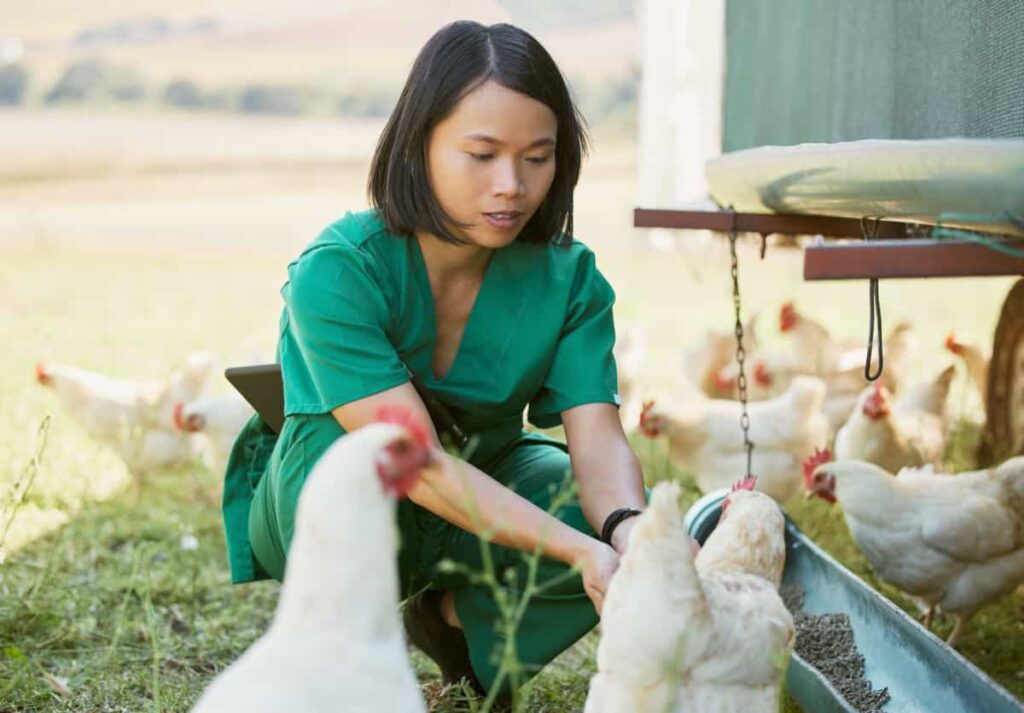
The digestion of poultry does not produce significant amounts of greenhouse gases, such as methane, compared to grazing livestock. Globally, poultry is raised in small, medium, and large-scale operations. Chicken production practices are committed to being environmentally responsible and sustainable to ensure a healthier planet for our children and future generations.
Ultimately, raising and producing chickens takes a healthy planet, fresh water, clean air, and fertile soil. In terms of the chicken industry, sustainability means being responsible stewards of resources such as land, water, and feed, as well as ensuring that our most valuable asset, chickens, are treated humanely and advocating for the right to do so.
As a result of continuous innovation and improving chickens’ health, the chicken industry has been able to significantly reduce its usage of water, farmland, electricity, greenhouse gases, and a variety of other valuable resources. The Indian poultry market was valued at INR 1,905.3 Billion in 2022, and expects the Indian poultry market to exhibit a CAGR of 10.18% during 2023-2028.
Sustainable Poultry Farming
Types of Poultry Birds
Chicken:
As a domesticated fowl, the chicken has become the most widely consumed poultry worldwide for its meat and eggs. The majority of meat consumed throughout the world is chicken meat. Therefore, there has been tremendous growth in the chicken meat market during the past few years, with the export of chicken meat reaching nearly 12.5 million metric tons by the start of the 21st century. Among the countries that produce poultry meat in the world, India is the fifth-largest producer. There are several indigenous cattle breeds in India, such as the Aseel, Chittagong, Basra, and Ghagus.
In case you missed it: Unlocking the Potential Of Sustainable Aquaculture: How to Start and What You Need to Know
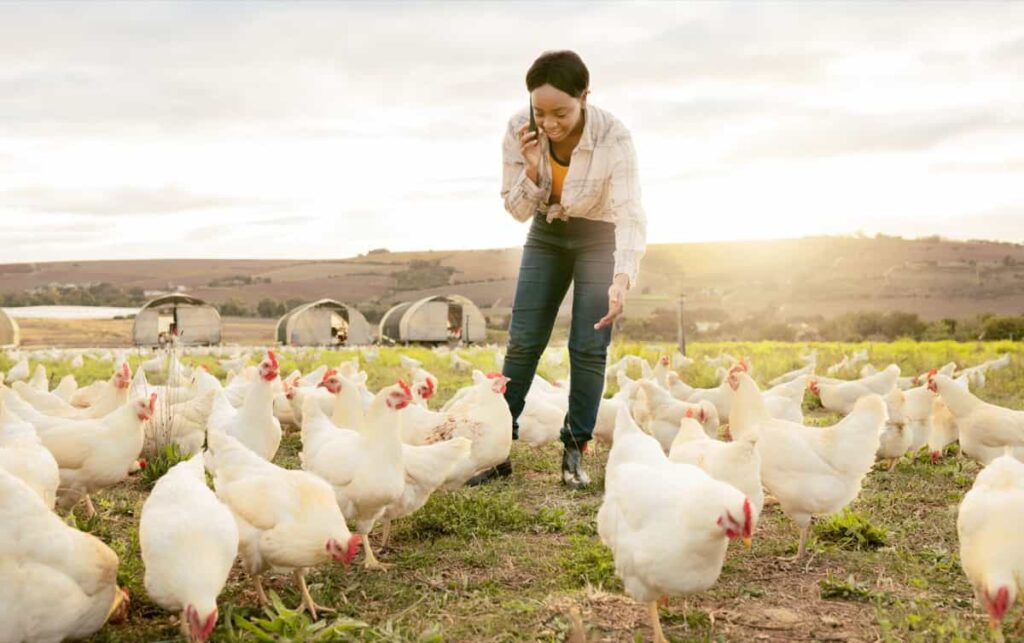
Turkey
With the proliferation of larger flocks after the second world war, turkey production became highly specialized. There is a long-standing tradition of raising turkeys in Canada. It is also common to raise turkeys in many countries, including the United States, Mexico, etc. Commercially, most turkeys are reared in rearing houses under environmentally controlled conditions to ensure their safety. Also, they can be raised on open land with automatic waterers, fenced house shelters, self-feeders, and rotated pastures.
Ducks and Geese
Ducks are raised in almost all countries but on a limited scale. The duck does not only provide eggs and meat by converting some waste and scattered grains into nutritious compounds through the process of metabolism. In addition, they are also very easy to transport. Approximately 300 eggs are produced every year by both Khaki Campbell and Indian Runner ducks, which are both layers.
Pekin ducks are one of the popular breeds used for producing eggs and meat in the United States. Raising geese is a minor farm enterprise, except in some European countries where these birds are produced in large numbers on a large scale. Both Toulouse and Embden are two of the most important goose breeds in the world and are commonly raised for their eggs, meat, and feathers.
Guinea Fowl and Squabs
In very few farms, these birds are raised as a sideline to being eaten as gourmet items. These birds are raised in yards with open-fronted shelters, and wide varieties and species of these birds are utilized worldwide. Pigeons are raised for meat and called squabs in the animal world. Most countries have established a poultry industry where the production occurs locally. Its meat is also sold as a gourmet item.
In case you missed it: How to Start Sustainable Pig Farming: Business Plan, Benefits, and Requirements
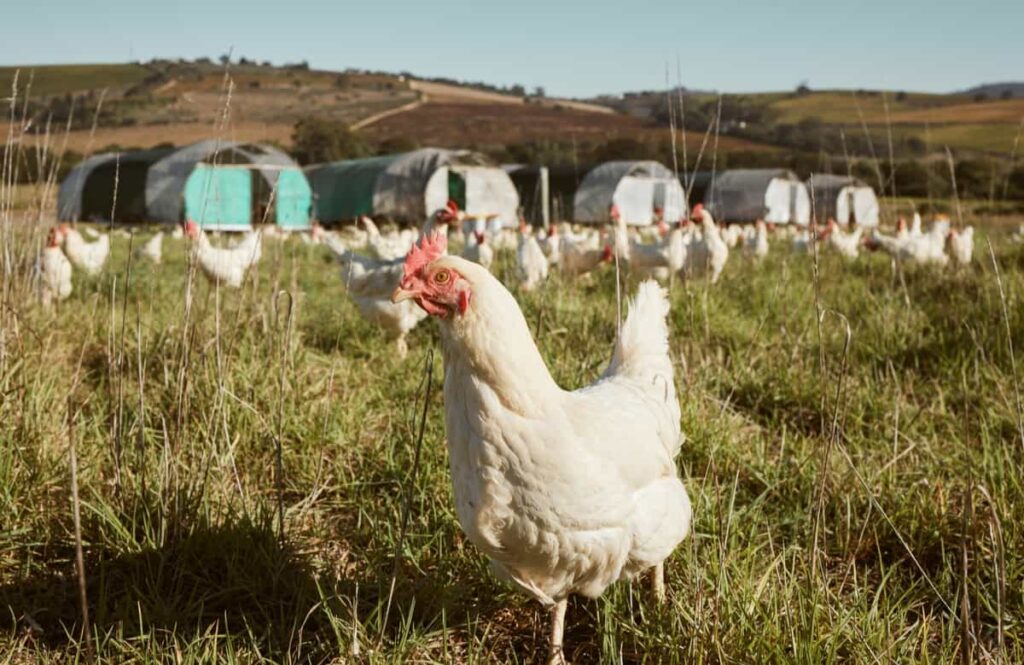
Housing and Shelter in Sustainable Poultry Farming
Almost all poultry farms are required to provide a carefully controlled environment that prevents crowding, chilling, overheating, or frightening of their animals. For an optimal yield of the poultry, it is necessary to maintain a clean, dry, well-ventilated, and well-illuminated house that can provide comfort and protection to the birds. Different aged birds should be kept in different cages, like growing birds, egg-laying birds, and brooding birds. It is common to keep poultry birds in wire cages or permanent brick houses with solid floors for protection.
It is recommended that the floor of the poultry house be covered with some dry absorbent material, such as paddy husk, chopped straw, sawdust, etc., to absorb moisture. The poultry sheds should be rat-proof and protected from predators such as cats and dogs by a fence surrounding them. Within the shed, the temperature is maintained between 34°C and 38°C throughout the year. For each baby chicken, provide a 700 square cm floor area on the deep litter until eight weeks of age.
250 baby chickens can be brooded in a hover with a one-meter diameter. Metal or bamboo baskets fitted with a heat source can be used as hovers. Hover sizes and numbers depend on how many baby chickens are to be brooded. A unit of 250 baby chickens is ideal for efficient management. Baby chickens can easily get in and out of the hover by hanging it from the roof or over bricks or stones. One to two watts per baby chicken is required for brooding. For every 250 baby chickens, use five 60-watt bulbs.
| Age in weeks | The temperature under hover, at 5 cm above the floor ( °C) |
| 0-1 | 35 |
| 0-2 | 32 |
| 2-3 | 29 |
| 3-4 | 26 |
| 5 | 23 |
Feeding requirements in Sustainable Poultry Farming
All the essential nutrients necessary for poultry should be included in poultry feed, such as carbohydrates, proteins, fats, vitamins, minerals, and water. The poultry feed consists of mashed cereals such as wheat, maize, jawar, Bajra, ground oil cakes, bran of rice, fish meal, bone meal (fish and meat meals are prepared from the wastes of fish and meat processing facilities), and meat meal.
In case you missed it: Sustainable Goat Farming: Business Plan, Benefits, and Requirements
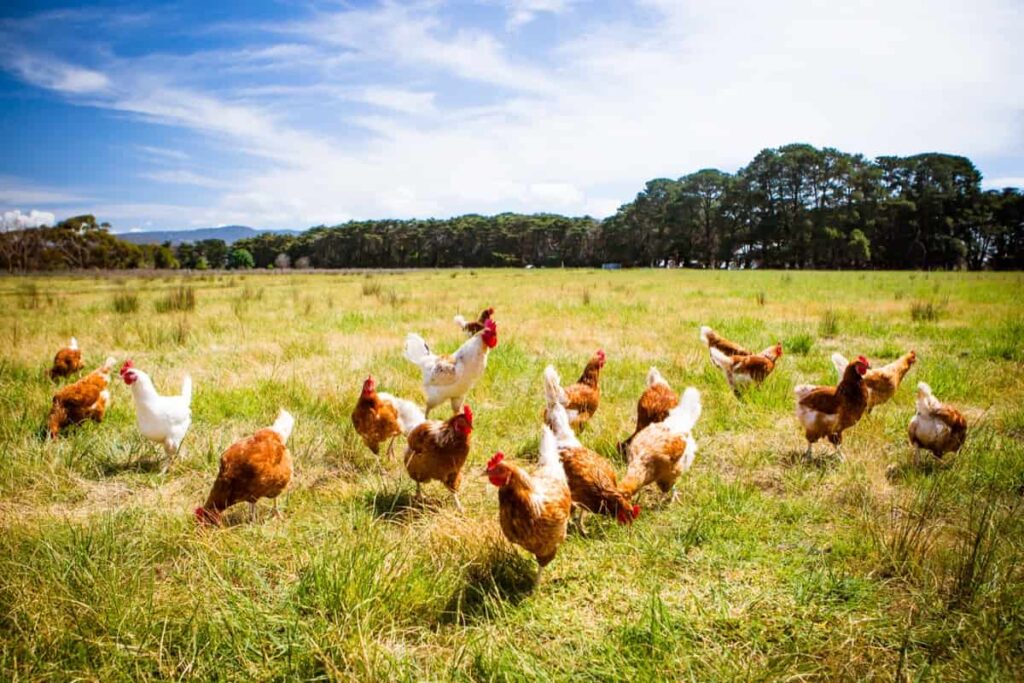
In contrast to layers, broilers require different amounts of food every day. Broiler feed is supplemented with proteins and adequate fat. Vitamins A and K are essential nutrients for poultry feed. Modern chicken feed produces an average of 0.5 kilograms of broilers from 0.9 kilograms of feed and about 2 kilograms of eggs from 2 kilograms of feed.
Water Management in Poultry Farming
Water usage on farms is measured and monitored by computer systems installed in growout houses where broiler chickens live and grow. Farmers identify water leaks by diligently observing abnormal patterns of water usage, which can be used to save water. A spring-loaded, pin-activated water dispenser is another water-saving tool used on modern chicken farms.
Water dispensers like these are similar to rabbit or hamster water bottles with ball bearings. Water is released when the birds press the pin. It helps prevent water from spilling on the poultry litter or floor and dispenses water when the birds are thirsty. A cooling system is also installed in most growout houses, consisting of cool cell pads at one end and large tunnel exhaust fans at the other. As a result, the chickens stay cool, and the farm’s water is recycled.
Litter Management in Sustainable Poultry Farming
Depending on the cost and availability, wood shavings, sawdust, paddy husk, peanut shell, paddy chaff, chopped straw, and other materials that absorb moisture well can be used. Spread the litter 5 cm deep on the floor before introducing baby chickens, and add litter material at a rate of about 2 cm per week until it reaches a depth of 15 cm. Approximately 10kg of litter material would be required per square meter.
At least twice a week during cold and rainy seasons, once a week during hot seasons, and the day after deworming, litter should be raked thoroughly. Litter should always be kept dry. The litter condition should be checked daily during the cold and rainy seasons and on floors where watering utensils are placed. Top-dress with fresh litter if necessary. The litter should be raked, and dry lime applied at a rate of 10 kg per 10 m3.
In case you missed it: Humic Acid Fertilizer Uses: Role, Application Methods, Dosage, and Benefits for Sustainable Agriculture
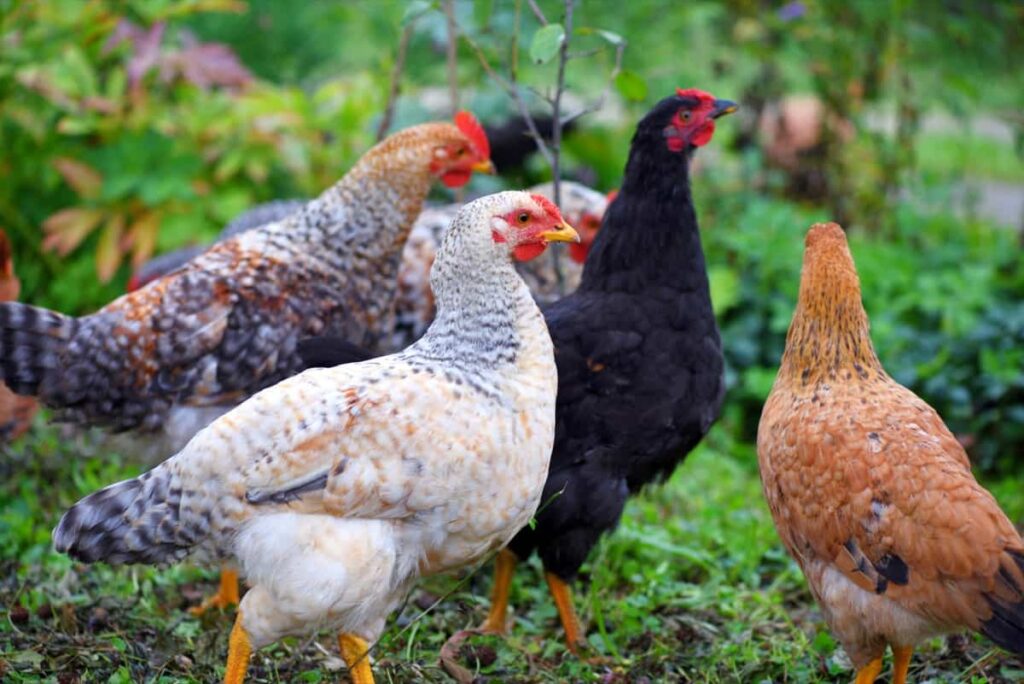
Disease Management in Sustainable Poultry Farming
For successful poultry farming, a disease-free condition is important. Fowls are vulnerable to numerous diseases. The cause of the disease may be from different modes of infections, from viruses, bacteria, fungus, and other agents, or even food deficiency or nutritional deficiency. Parasitic diseases of poultry, including hexamitiasis of turkeys, are caused by roundworms, tapeworms, lice, and mites. Again, modern methods of sanitation, prevention, and treatment provide excellent control.
Hence, regular and proper cleaning, sanitation, and spraying of pesticides and disinfectants should be performed to keep the surroundings clean, tidy, and free from all microbes. Additionally, all domestic birds are vaccinated to control the disease and increase in backyard birds. Vaccination is commonly used as a biological preparation that helps prevent infection occurrence and spreading.
Prevention of Poultry Diseases
If proper measures are not taken, poultry diseases might result in greater losses. Several poultry diseases can be prevented using some simple steps. Following are some of these steps
- A clean, hygienic environment is essential for keeping birds.
- Excreta should be disposed of properly and regularly.
- A spacious, ventilated, and bright environment is essential for birds.
- All animals must be vaccinated against common diseases and infections.
- In proper quantities, nutrient-rich food supplements can prevent nutritional diseases.
- For parasites and mosquitoes to be killed, disinfectants must be sprayed regularly.
- A dilute insecticide solution must be applied to control external parasites.
Benefits of Sustainable Poultry Farming Business
There are so many benefits associated with poultry farming, along with business opportunities. These benefits make poultry farming a popular business among farmers. Eggs, meat, and poultry are the main products of poultry farming. Many chickens were raised in poultry farms to produce eggs and meat. Poultry farming offers many benefits, some of which are listed below.
In case you missed it: The Importance of Soil Health in Farming: Role of Soil in Sustainable Agriculture
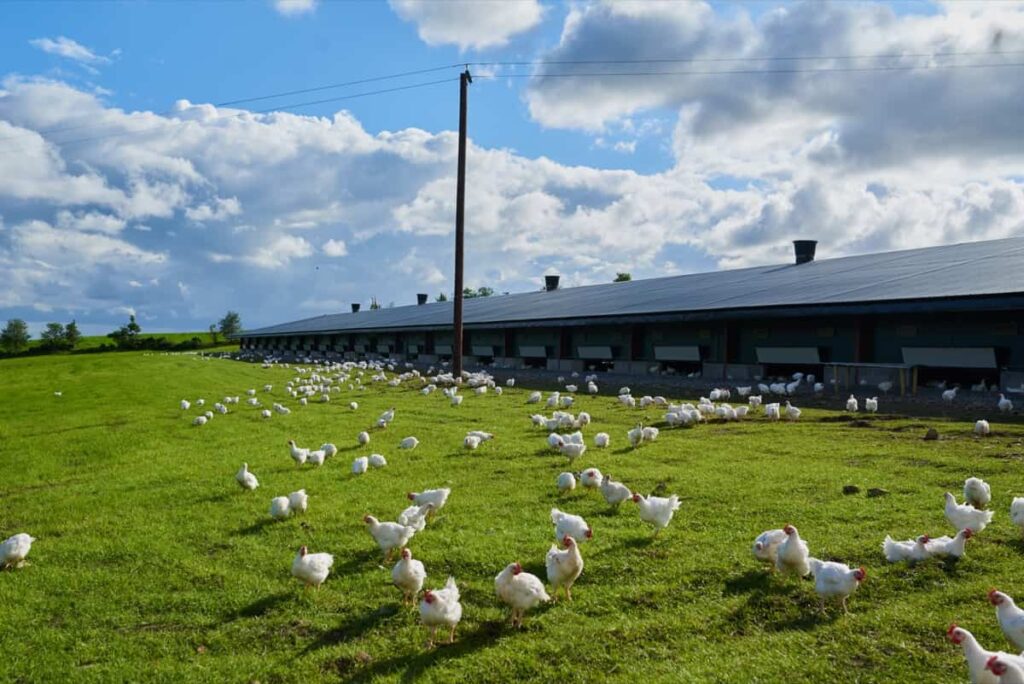
- Big Space is Not Required: Since these birds do not require any special space for their growth, poultry farming does not require a large space. For their safety, all they need is a cage.
- Require Less Capital: A poultry farm does not require more capital than a conventional farm. The only investment required is to buy the birds and food to feed them. Therefore, anyone can start a Poultry Farming business to profit on a large scale since the demand for this business is high.
- High-Profit Rate: Poultry farming is one of those businesses providing a large profit. In addition to being cost-effective, animal husbandry practices produce more profit than expected. It is also possible to start this business from a few birds and expand it there.
- Require Low Maintenance: Due to this practice, birds also require high maintenance. You can protect these birds from harmful diseases by taking care of a few things for a very small investment. It is only necessary to maintain a clean and healthy environment.
- License is Not Mandatory: A license from the government is not required in poultry farming practice. When you practice it on a small scale, you do not need a license, but when you do it on a large scale, you will need a license, which you can easily acquire.
- Easy Marketing: Due to their high demand, poultry farming products are very easy to sell. As a result, they do not have to spend much time and effort trying to sell them.
- Income & Employment Opportunities: Many people earn an income and find employment through poultry farming. This can easily provide a source of income for unemployed educated youth.
In case you missed it: A Guide to Sustainable Cover Crops: Examples, Types, Benefits, and Disadvantages
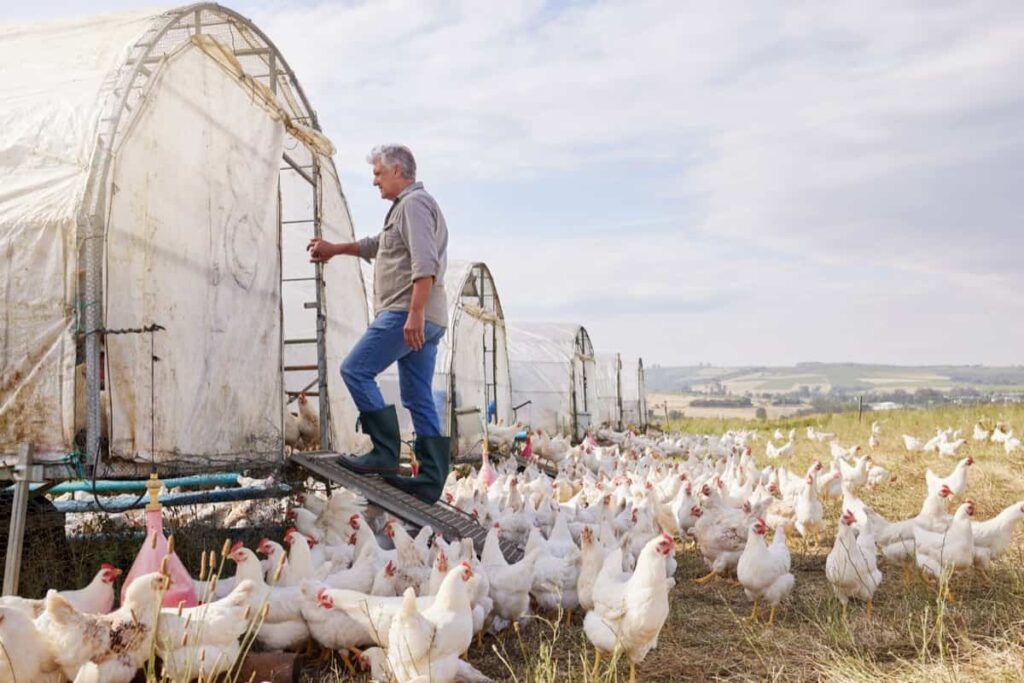
Conclusion
The majority of non-vegetarians find poultry products to be a cheap source of animal protein. As a result, it is one of the fastest-growing segments of animal husbandry. Layers are female poultry birds that lay eggs, while broilers are female poultry birds that produce meat. Poultry birds benefit humans in many ways since they convert agricultural byproducts into eggs, meat, and rich manure. Even though eggs and meat are the main byproducts of poultry farming, feathers can also be used in various ways.
- How to Raise Pigs in Your Own Backyard: A Comprehensive Guide
- Budget Friendly Sheep Shed Ideas: Cheap and Low-Cost Tips
- How Much Do Cattle Farmers Make: Revenue Streams in Cattle Farming
- Management Pests and Diseases in Your Cotton Field
- Sheep Farming Business Plan for Beginners
- Aquaponic Farming at Home: A Step-By-Step Guide
- Profitable Village Farming Business Ideas in 2024
- High-Yield Aquaculture: Fast-Growing Fish for Farming
- Effective Fish Pond Construction Techniques for Beginners
- Irrigation and Water Management in Pineapple Farming
- Blossom to Harvest: Mastering Flowering and Pollination in Papaya Farming
- Pig Fattening Essentials: From Selection to Sale for Beginners
- Raising Wagyu Cattle: A Complete Guide for Premium Beef Production
- Soil Types and Their Water Holding Capacity
- Optimizing Irrigation Schedules for Coconut Groves for Enhanced Yield
- Espresso Your Garden: Coffee Grounds for Healthier Acid-Loving Plants
- The Best Soil Mix for Snake Plants: How to Mix Your Own Snake Plant Soil
- Green Thumb Success: Expert Tips for Cultivating Greenhouse Beans All Year Round
- Bloom All Year Round: The Ultimate Guide to Indoor Hyacinth Care
- Eco-Friendly Gardening: How to Make Liquid Fertilizer from Kitchen Waste
- Ultimate Guide to Grow Anise in Pots: Explore Seed Propagation to Harvesting
- Guide to Raising Chester White Pigs: Discover Breed Facts to Growth Management
- Mastering the Elegance: The Ultimate Guide to Weeping Cherry Tree Care, Planting, and Maintenance
- Ultimate Guide to Planting Garlic in Grow Bags: Growing Strategies for Beginners
- How to Fix Spider Plant Leaf-Related Problems: Natural and Organic Remedies
- 10 Reasons Why Your Tulsi Plant is Shedding Leaves: Home Remedies and Solutions
- Optimizing Growth and Yield: The Advantages of Palm Bunch Ash Fertilizer
- Utilizing Neem Oil Extract as a Natural Pesticide for Hydrangea
- From Soil to Harvest: Various Ways in Which Farmers Can Use AI Tools
- Steps to Encourage and Induce Citrus Flowers: A Comprehensive Guide
- How to Fix Snake Plant Leaf-Related Issues: Natural and Organic Remedies
- Transform Your Garden into a Fragrant Oasis with Raat Ki Rani (Night Blooming Jasmine)
- Discover the Ideal Chicken Breeds for Philippine Farms
- How to Create a Poultry Egg Farm Business Plan for Profits
- Grow Lemon Cucumbers Like a Pro: Insider Techniques for Bountiful Yields
- Ultimate Guide to Caring for Your Pink Princess Philodendron: Tips for Thriving Variegation
